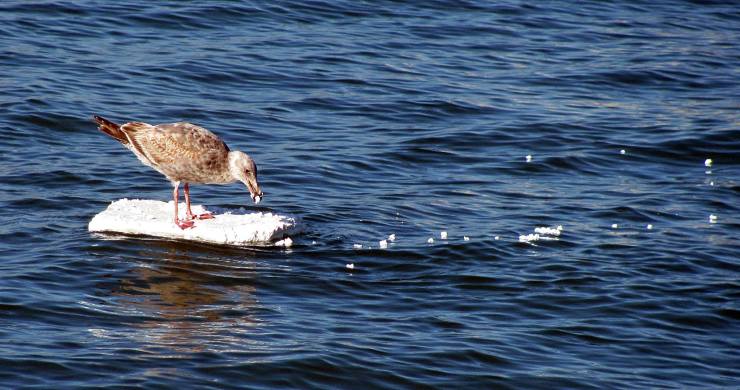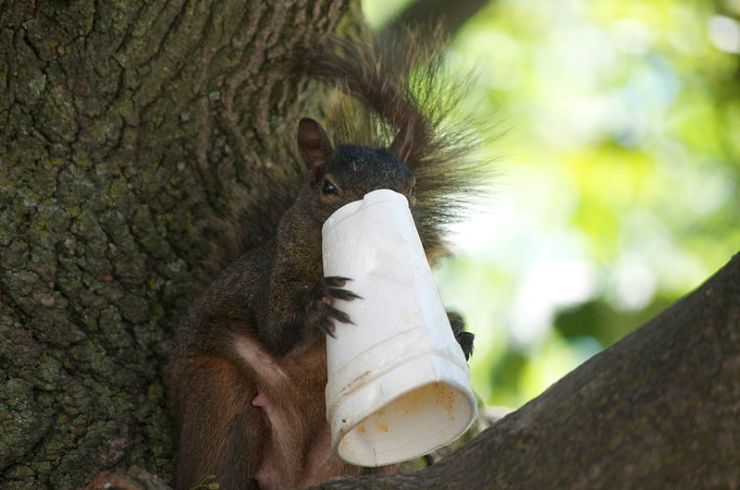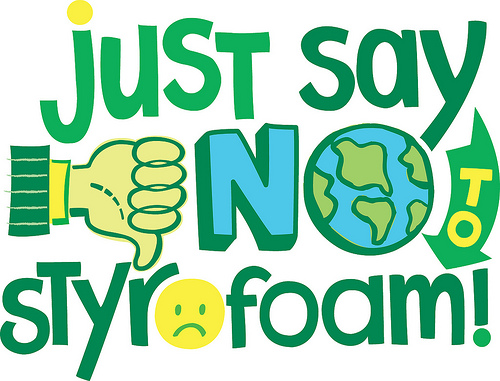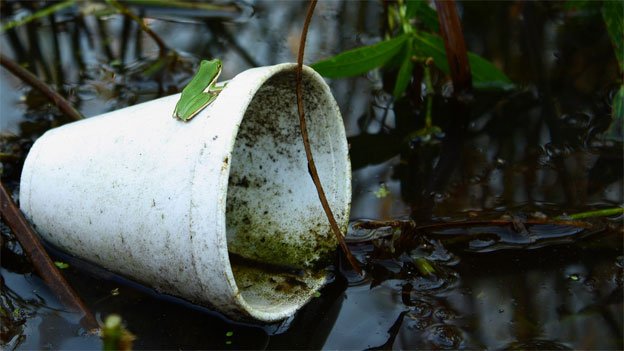Styrofoam is an environmental and health hazard from start to finish!
You think your food tasting so good because of the seasoning, or your coffee satisfying your soul because of the rich organic beans?
Well, guess again ………… it’s probably a secret ingredient called STYRENE!
Let’s get technical for a bit.
What is styrene you may ask? You may know it as Styrofoam however Styrofoam” is actually just a brand name! The real Styrofoam™ was invented in 1941 by Dow Chemical and is used exclusively in building insulation, to float docks, and in some molds for floral arrangements.
The white plastic items we incorrectly refer to as Styrofoam are very similar, however;
- The trademarked product called Styrofoam is produced using a closed-cell extruded polystyrene foam.
- The white disposable coffee cups, coolers, takeout containers, and packing peanuts refers to expanded (not extruded) polystyrene foam, which is sometimes referred to as EPS.
Polystyrene is actually just another type of plastic- a petroleum-based lightweight plastic made from styrene (a synthetic chemical) and benzene.
So what’s the problem?

Every day in Trinidad 32.9 tons of Expanded Polystyrene foam containers go to the landfills. What doesn’t reach the landfills is in our drains, our roads, our beaches, our rivers literally EVERYWHERE!
We (you and I) have a dangerous consumption pattern of styrofoam and its due to our lack of knowledge, our silence as consumers and its availability on the market.
Why is it so readily available to us well its simple styrofoam its cheap, lightweight, easy to carry, an effective insulator of food and it is white which is perceived as being sterile and hygienic.
So let’s talk about health.
- Styrene is a neurotoxin and is also known to have toxic effects on the central nervous system.
- Neurological effects have been observed in workers continually exposed to styrene through inhalation.
- In 2011, styrene was listed as “reasonably anticipated to be a human carcinogen” by the National Toxicology Panel (Department of Health and Human Services, 2011).
- Exposure to styrene vapor can cause irritation in the eyes, nose, throat and skin as well as poison the liver.
- It causes irritation of the upper respiratory tract
- Chronic exposure to styrene leads to further complications, including effects on the nervous system. Symptoms of chronic exposure include those listed below:
- Depression
- Headache
- Fatigue
- Weakness
- Minor effects on kidney function
-
Polystyrene containers are commonly used for take-out food, but chemicals can leach into it and contaminate that food, affecting human health and reproductive systems. This effect is further accentuated if food is reheated while still in the container.
NEVER heat Styrofoam: always remove food to a cooking vessel for reheating.
Again this isn’t just bad for our health, its horrible for the environment.

“Styrofoam” is one of the country’s most visible forms of litter. We clearly love to see our rivers, drains and streets decorated with white cups and containers, it’s absolutely beautiful! Looks just like snow!
You may be thinking if you dispose of it properly then you’re not harming the environment. Guess again!
- It Lasts (almost) forever. “Styrofoam” is non-biodegradable i.e when it reaches the landfills it just sits there for at least 500 years chilling living a lonely life as all the other waste products break down beside it.
- It Contributes to air pollution and climate change. If polystyrene is burned or incinerated, it releases toxic carbon monoxide into the air. The manufacturing process for polystyrene foam also releases a number of toxic chemicals detrimental to our health and the ozone layer.
- It Comes from a non-sustainable source. Polystyrene is made from petroleum, a non-sustainable product.
- It Harms wildlife. Polystyrene often makes its way into the environment, especially waterways and are frequently consumed by both land and marine animals causing blockage of their digestive system, choking, and death.

Well, its an obvious solution to the problem is to recycle polystyrene right ?????
Nope ! Polystyrene foam is 95% air so it is not cost-effective to store or ship. Also, it is often contaminated with food or drink and is difficult to clean because it is so porous. Basically, it is just not feasible.
So what’s the answer?

There are greener and safer options. Biodegradable packaging is just as effective for transporting food as its Polystyrene counterpart – but instead of remaining in the environment for hundreds of years, it breaks down naturally limiting the environmental impacts.
Firms such as Caribbean Containers Inc have developed ECO PAK containers, which provide similar functions as Expanded Polystyrene foam but within 90 days they biodegrade.
Our main manufacturers can invest in eco-containers and connect with local farmers to source raw materials for their products thus cutting cost on importation. Moreover, the more companies that produce eco-friendly packaging the cheaper it will be on the market thus consumers wouldn’t have to carry the burden of a cost increase in goods.
Currently expanded polystyrene has 0% of duty rate when entering the country, while other products, like containers made of bamboo has a duty rate of 20%. If this rate is significantly decreased or subsidized by the government then there would be no need for a price increase.
While the current international trend is to ban this material from the markets, the rates of duty in Trinidad and Tobago only serve to stimulate the consumption of polystyrene containers. In order to create an attractive market environment to stimulate the introduction of alternative and sustainably designed packaging, policies and duties need to be reviewed in favour of sustainable packaging, products and materials.
A percentage of 57.79% of Expanded Polystyrene foam containers are produced locally in Trinidad and Tobago. Sanicup, the brand produced by Santainers occupies the largest market share in this country so it is only fair that they would express concern over their industry. However, to say that eco-friendly packaging is just as detrimental to the environment as Styrofoam is completely erroneous an effort to sway and mislead the public from the truth.
Santainers is solely seeking their best interest and ignoring the public’s health and safety.
Instead of attacking eco-friendly packaging why not invest in it?
Instead of discrediting the health effects why not take a stance for your customers’ health and provide them with a safer option?
Profits are so important that you are willing to put money before your customers?
This is an opportunity for Santainers to be innovative, to be eco-friendly, to connect with the country’s agriculture sector and to be the wave of change that the country needs.
It’s time we ban Styrofoam our health depends on it!
We have a voice! Let’s use it!
We need the earth more than it needs us!


Good informative read
LikeLiked by 1 person
Good read! Actually had no idea styrofoam was just the brand name.
LikeLike
Also your posts always make me think twice before doing everyday, common things which negatively impact the environment…i try not to use plastic bags so now to try to not use styrofoam x_x
LikeLike
It’s engraved in us and we which includes me never thought twice abt a lot of things until living in london. All we can do is try its very difficult when we don’t have systems in place to support the behaviour change necessary but that shouldn’t stop us from at least trying.
LikeLike
True but policy along with good communication campaigns can really help with the behaviour change..but try we must for now!
LikeLike